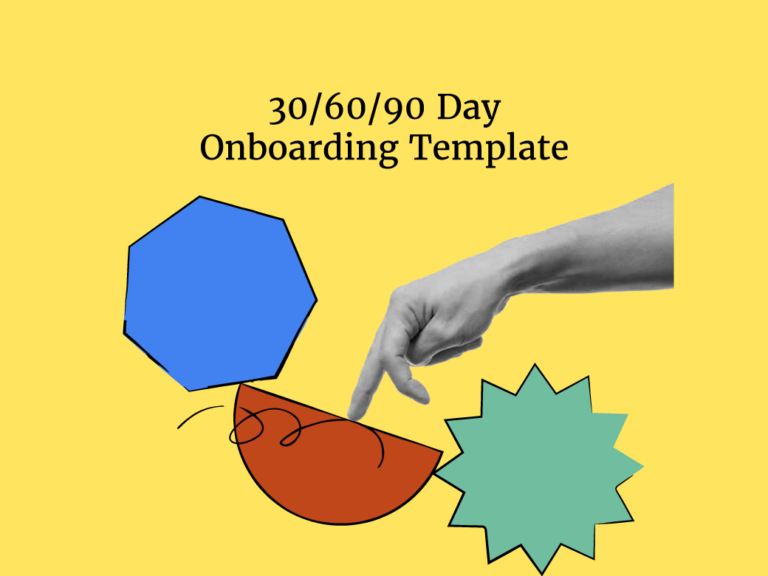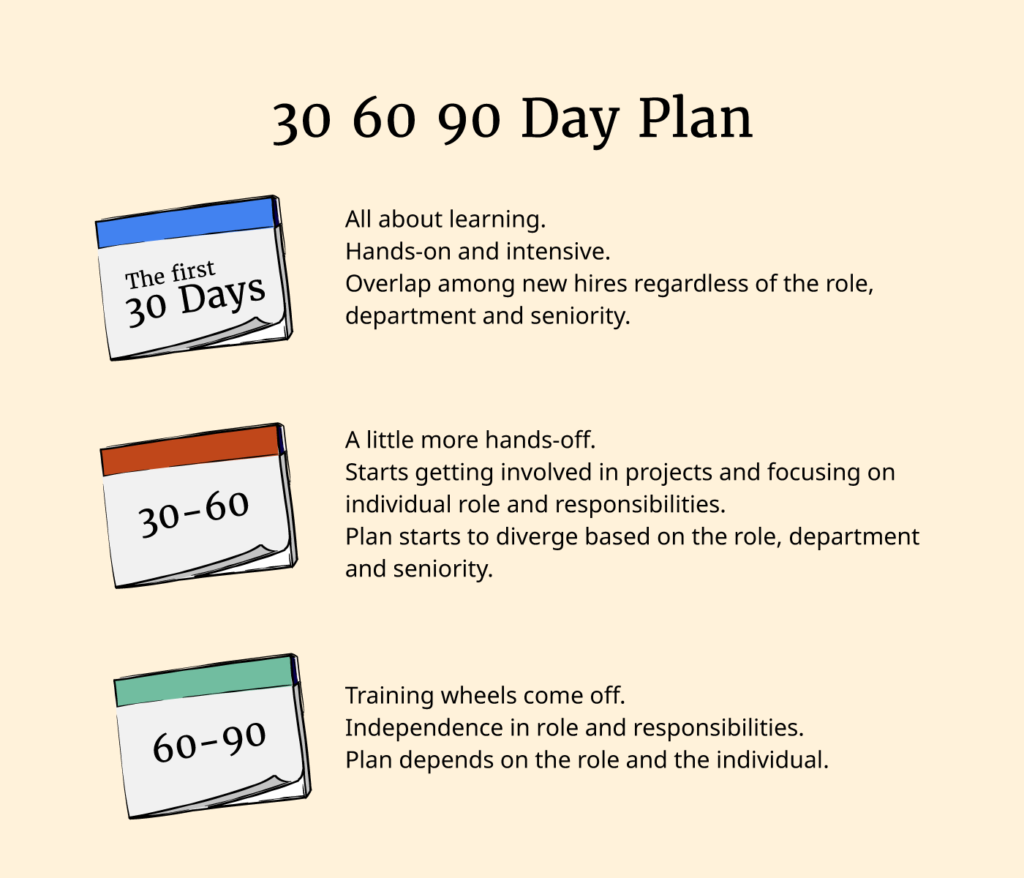A study from Gallup found that only 12% of employees strongly agree their organization does a great job of onboarding new team members.
This is disappointing because, as we'll go into, a proper onboarding process can have a significant impact on the new hire's success in their new role.
So how can you ensure your process is getting people off to the best possible start?
The 30-60 90-day onboarding plan is widely recognized as a best practice for integrating new team members effectively into the company culture and ramping up their productivity.
While there are many ways to improve your onboarding experience, making use of the 30 60 90 day plan has one of the best ROIs I know of.
So let’s dive in.
Your 30-60-90-day template
Here's our tried and true onboarding template to start off your new employee experience the right way.

Get our Onboarding template!
What Is A 30-60-90-Day Plan?
A 30-60-90-day onboarding plan is an action plan that helps guide new employees through the first 90 days in their new job. It helps create and track the completion of typical onboarding tasks such as meeting colleagues and completing necessary training.
The ultimate objective is to make new starters feel welcome and to help them prioritize what they should be doing to get productive as quickly as possible.
In turn, this will also help boost employee engagement, motivation and retention.
The first 30 days
The focus on the first 30 days is all about learning more about the org, their role, the tools they’ll be using, how success is measured, and the part they’ll play.
It's as much about figuring out what the new starter needs to learn too, starting with the basics.
This portion of the 90-day plan will have the most overlap across all new hires regardless of role, department, or seniority.
The 30-60 day range
Here new starters still have the training wheels on but are starting to get more involved in projects and focus on their roles and responsibilities. This period is where the plan starts to diverge depending on the role, department, and seniority.
The 60-90 day range
Now the training wheels have come off the new starter now has more leeway and independence regarding how they want to go about tackling their role and the responsibilities with it.

Benefits Of A 30-60-90-Day Plan
A 30-60-90 day onboarding plan offers a structured framework for new employees to adapt to their roles and responsibilities within an organization. This plan is beneficial in several key ways:
- Greater efficiency. Making a 30-60-90 day onboarding plan should make the process more efficient by ensuring everyone knows what’s required of them and what resources are going to be needed. It’s also easier to bundle resources including introductory presentations and the like.
- Faster time to competency: By providing a clear roadmap, new hires have a better chance of reaching full productivity more quickly than they might with an unstructured plan.
- Feedback and adjustment opportunities: The plan will set regular check-ins and feedback sessions between the new employee and their manager or mentor. This ensures that any challenges are addressed promptly, and adjustments can be made to the plan if necessary. It supports continuous improvement and personal development.
- Stronger culture: A structured onboarding gives new hires a strong chance of feeling more connected with the organization, its people, and adding to the company culture. This is especially important for remote or global onboarding.
An Analogy For Thinking About Your 30-60-90-Day Plan
I once took an onboarding course where the instructor said "A good way to think of your 30 60 90 day plan is like a food menu. "
As is custom, appetizers first.
This is what's going to be included in all 30-60-90-day plans, regardless of department or seniority.
It's the information everyone should know when joining a new organizaion, for example:
- Values
- Goals
- Business model
- History
Now we can get more specific.
Using our food menu analogy, these are the main dishes. For example, someone in a sales manager role will have different goals and metrics from someone starting a new position in software development.
From this, you can create various templates depending on the department or seniority level.
Finally, we get down to the individual level or, continuing the analogy, the garnishments.
Everyone has different experiences, outlooks, personalities, and goals. You want to work with them in coming up with some adjustments to their 90-day plan that fits them best.
How can you do this? One of the best ways to do so is by making use of the entry interview.
With this entry interview, you can gain a much deeper understanding of their personality, strengths, weaknesses, and personal goals and adjust the 90-day plan in accordance with those.
While there is overlap between the type of interview questions that you'd ask between the entry interview and the job interview, the type of questions and answers you're looking for will be different than the interview process itself.
This interview can be conducted by a hiring manager, their new manager, or both.
Through the entry interview, you can have their plan on hand to make adjustments as needed to ensure they get the best 90-day plan possible.
If you’re anything like me, you might now be casting your mind towards dessert. Well that’s the culmination of all the preparation and hard work over the 90 days resulting in a ready, engaged and motivated employee!
Now let’s dig further into how to create a 30-60-90-day plan.
How To Create A 30-60-90-Day Plan
The First 30 Days
Now let's look at what to include in the roadmap of the first 30 days of a new hire’s role.
The first month or so is going to involve a lot of learning. This is the period in which you’ll be most hands-on with the new hires to get them adjusted to your organization and where there’ll be the most overlap in what gets covered, regardless of role or seniority.
As a result, this portion will be easiest in regards to creating reusable elements.
Here are some things that you will want new hires to cover in those first 30 days:
- Get clarity on the role and responsibilities (super important)
- Be aware of employee policies and expected behaviors
- Gain an understanding of the technology, software, tools that your organization uses and processes they'll be following.
- Learn about your org’s mission, vision, values, products, business model, and customers
- Gain an understanding of the stakeholders of the organization
- Gain an understanding of the current projects that the organization is focusing on and what they will be focusing on in their role
- Have weekly meetings with their manager
- Develop an understanding of your company culture and team norms.
- Get to know their fellow team members and who to go to for what
- Identify skills gaps and draw up some short and long-term goals for the remainder of the plan.
As the first 30 days will be the new hire’s first in the office (physical or virtual), it’s worth developing some reusable employee orientation activities like welcome presentations, reading the employee manual, and team lunches.
The 30-60 Day Range
Now that new hires have crossed the 30-day threshold, it’s time for them to dip their feet further in the water.
They’ll now have an understanding of the basics and start delving deeper into their role.
The knowledge gained from the first 30 days will now be ramped up and put into action and they can get more involved in projects and start to speak up more with their thoughts and ideas.
The roles and responsibilities that new hires go over when they started? They can now begin to make progress on this front.
The KPIs, goals, and milestones that you set in the previous 30 days? They’ll start making headway on them.
This is the part of the 30 60 90 day plan where each plan begins to diverge depending on the department, individual, or seniority level.
The 60-90 Day Range
At this stage, the new hire continues to make headway through the KPIs, specific goals, and milestones that were created in the first 30 days.
As this timeframe has a much greater emphasis on independence, this section of the plan can be much more open-ended and tailored to the individual.
New hires will be working on projects with less supervision, be more involved with their teams and the organization as a whole, and follow up with their managers to ensure that they are hitting their metrics.
At this point, team members can begin to go to the new hire for their expertise. Maybe they make a new team for a project they're working on.
Mistakes will still be made and that’s fine. They’re still new to the organization and they still have many things to learn.
That said, there needs to be a higher level of accountability compared to earlier in the 90-day plan, which will only continue to grow as time goes on.
Beyond 90 Days
Studies show that around 72% of new employees will have settled into their new role within 3 months, with 22% by 9 months, and the rest around 10-12 months.
One of the best things that your organization can implement after the 90 day period is the stay interview.
The stay interview is interviewing employees about what has been working well, and where improvements can be made.
The stay interview is an excellent way to improve your onboarding process. It’s a great time to ask questions about how well the plan was laid out, how it was executed, and where it can be improved.
Feedback from stay interviews can be buttressed by another feedback method such as onboarding surveys.
Some useful metrics to measure the success of onboarding include new hire turnover, time to productivity, and training completion rate or test scores.
The rule of 5
When it comes to improving your 90-day plan, consider the rule of 5.
The rule of 5 states that when getting insight into research or testing, five users tend to be enough to identify patterns and determine what does and doesn’t work.
If you’re getting patterns already emerging after simply asking five users, you’re going to more or less get the same information if you test more than 5. If no patterns are emerging within five users, then you can test more.
For example, if your feedback consistently highlights that KPIs and goals need to be more clear in the 90-day plan, it’s a good idea to hone in on that and find ways to improve the process.
30-60-90-Day Onboarding Best Practices
To finish up, I wanted to focus on some best practices for creating your 30-60-90-day plan as well as onboarding in general.
Set clear, achievable objectives
For each phase of the plan (30, 60, 90 days), set clear and measurable objectives that align with the employee's role and the company's goals. Ensure these objectives are realistic and attainable, providing a sense of achievement as they are met.
Schedule regular check-ins and feedback
Arrange for regular one-on-one meetings between the new employee and their manager or mentor as well as HR staff, the recruiter that hired them, and someone from talent development. These sessions are crucial for providing feedback, discussing challenges, and adjusting the plan as necessary.
Encourage self-reflection and goal setting
Motivate the new hire to reflect on their progress and set personal and professional goals. This encourages engagement and personal investment in their success within the company.
Highlight success and recognize achievements
Celebrate milestones and achievements throughout the onboarding process. Recognition can boost morale and motivation, reinforcing the employee's value to the team and company.
For example shoe retailer Zappos throws a "graduation party" for those who complete the mandatory customer service segment of their onboarding.
Here are some more awesome employee recognition ideas.
Adjust based on feedback
Be prepared to adjust the onboarding plan based on feedback from the new employee (onboarding surveys or exit interviews are useful here) and their performance.
Flexibility is key to addressing any unforeseen challenges or opportunities for additional learning.
Use technology
Technologies such as specialist onboarding software and learning management systems help track progress and design and administer training.
Subscribe To The People Managing People Newsletter
For more on creating an exemplary onboarding experience, subscribe to our weekly newsletter for HR and business leaders. You'll receive all our latest content to help you grow in your career and make greater impact in your org.



